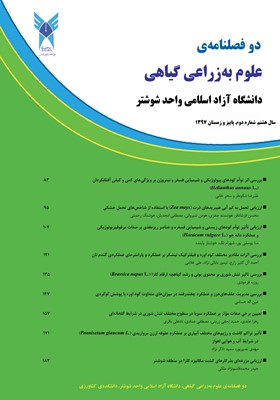تأثیر تراکم کاشت و رژیمهای مختلف آبیاری بر عملکرد علوفه ارزن مرواریدی (Pennisetum glaucum L.) در شرایط آب و هوایی اهواز
محورهای موضوعی : زراعتمهدی نصیرپور 1 , سعید ذاکر نژاد 2
1 - 1- دانش آموخته کارشناسی ارشد زراعت، واحد اهواز، دانشگاه آزاد اسلامی، اهواز، ایران
2 - 2- مربی، گروه زراعت، واحد اهواز، دانشگاه آزاد اسلامی، اهواز، ایران
کلید واژه: تراکم بوته, رژیم آبیاری, علوفه, واژه­, های کلیدی: ارزن مرواریدی,
چکیده مقاله :
بهمنظور بررسیتأثیر تراکم کاشت و رژیم های مختلف آبیاری بر عملکرد علوفه ارزن مرواریدی دراهواز آزمایشی در سال زراعی 1396 در شهرستان اهواز اجرا گردید. آزمایش به صورت کرتهای خرد شده در قالب طرح بلوک های کامل تصادفی در سه تکرار انجام شد. در این آزمایش رژیم آبیاری در سه سطح (90، 120 و 150 میلیمتر تبخیر از تشت تبخیر کلاس A) بهعنوان عامل اصلی و تراکم بوته در چهار سطح (20، 30، 40 و 50 بوته در مترمربع) بهعنوان فاکتور فرعی در نظر گرفته شد. نتایج نشان داد تیمار رژیم آبیاری بر وزنتر و خشک برگ، وزن تر و خشک ساقه، ارتفاع بوته، قطر ساقهو غلظت کلروفیل a و b در سطح احتمال یک درصد معنی دار بود. عامل تراکم بوته نیز بر وزنتر و خشک برگ، وزنتر و خشک ساقه و ارتفاع بوته در سطح احتمال یک درصد معنی دار بود. برهمکنش رژیم آبیاری و تراکم بوته بر وزنتر و خشک برگ، وزن تر و خشک ساقه، ارتفاع بوته و قطر ساقه در سطح احتمال یک درصد معنی دار بود. بهطور کلی با توجه به نتایج بدست آمده می توان عنوان کرد که با افزایش شدت تنش خشکی تمام صفات مورد بررسی کاهش یافتند. لذا با در نظرگیری شرایط محیطی منطقه آزمایش انجام آبیاری پس از90 میلیمتر تبخیر از تشتک تبخیر تیمار مناسب تری میباشد. همچنین در بین تراکمهای مورد بررسی، تراکم 50 بوته در مترمربع نیز بیشترین عملکرد بیولوژیک علوفه ای کل ارزن را به خود اختصاص داد. بهعنوان نتیجه نهایی بهترین تیمار به دست آمده استفاده از تراکم 50 بوته بر مترمربع و انجام آبیاری پس از 90 میلیمتر تبخیر از تشتک تبخیر اعلام و تعیین شد.
In order to investigate the effect of planting density and different irrigation regimes on the yield of pearl millet in Ahvaz, Iran, in 2017, was carried out. The experiment was conducted as a split-plot based on randomized complete block design with three replications. In this study, the irrigation regime was considered as the main-plot at three levels (90, 120 and 150 mm evaporation from class-A evaporation pan) and the plant density as the sub-plot at four levels (20, 30, 40 and 50 plants/m2). The results showed the irrigation regime had a significant effect on fresh and dry leaf weight, fresh and dry weight of stem, plant height, stem diameter, and chlorophyll a and b at 1% probability level. Also, the plant density had a significant effect on leaf fresh and dry weight, fresh and dry weight of stem, plant height and stem diameter at 1% probability level. The interaction of irrigation regime and plant density on leaf fresh and dry weight, fresh and dry weight of stem and plant height was significant at 1% probability level. In general, according to the results, it can be concluded that with increasing drought stress all measured traits decreased. Therefore, considering the environmental conditions of the experimental area as well as the economic aspects of applying and performing irrigation after 90 mm of the evaporation pan, treatment is more suitable. Also, among the densities studied, the density of 50 plants/m2 had the highest biological yield of total forage millet. As the final result, the best treatment was determined using a density of 50plants/m2 and irrigation after 90 mm evaporation from the evaporation pan.
_||_


